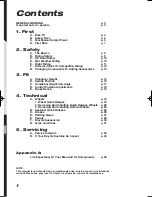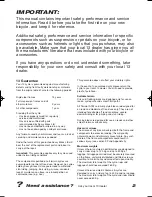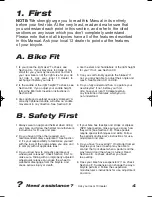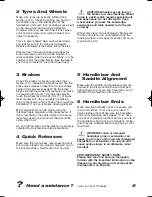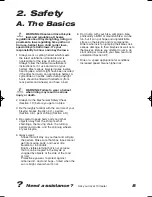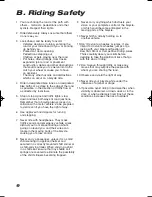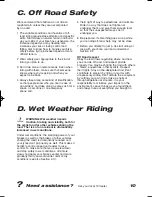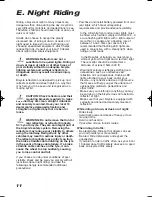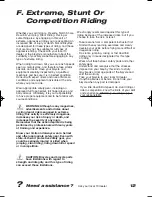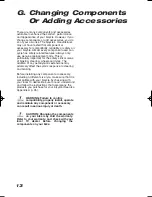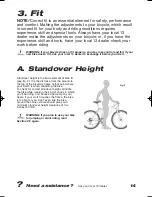
?
Need assistance?
Ask your
local 13 dealer
6
2 Tyres And Wheels
Make sure tyres are correctly inflated (see
Section 4.G.1). Check by putting one hand on
the saddle, one on the intersection of the
handlebars and stem, then bouncing your weight
on the bike while looking at tyre deflection.
Compare what you see with how it looks when
you know the tyres are correctly inflated; and
adjust if necessary.
Tyres in good shape? Spin each wheel slowly
and look for cuts in the tread and sidewall.
Replace damaged tyres before riding the bike.
Wheels true? Spin each wheel and check for
brake clearance and side-to-side wobble. If a
wheel wobbles side to side even slightly, or rubs
against or hits the brake blocks, take the bike to
your
local 13 dealer
to have the wheel trued.
CAUTION: Wheels must be true for
the brakes to work effectively. Wheel
truing is a skill, which requires special tools
and experience. Do not attempt to true a
wheel unless you have the knowledge,
experience and tools needed to do the job
correctly.
Wheel rims clean and undamaged? Make sure
the rims are clean and undamaged along the
braking surface, and check for excess rim wear
(see Section 4.C).
3 Brakes
Check the brakes for proper operation (see
Section 4.C). squeeze the brake levers. Are the
brake quick-releases closed? All control cables
seated and securely engaged? Do the brake
blocks contact the wheel rim squarely and make
full contact with the rim? Do the brake blocks
touch the wheel rim within 25 mm (1”) of brake
lever movement? Can you apply full braking
force at the levers without having them touch the
handlebar? If not, your brakes need adjustment.
Minor adjustments can be made using the
threaded cable adjusters at the brake levers. If
this is insufficient, the cable clamp at the brake
lever may need to be moved or there could be
some other fault.
Do not ride the bike until the brakes are properly
adjusted by a professional bicycle mechanic.
4 Quick Releases
Make sure the front wheel, rear wheel and seat
post quick releases are properly adjusted and in
the locked position. See Section 4.A and 4.B.
5 Handlebar And
Saddle Alignment
Make sure the saddle and handlebar stem are
parallel to the bike’s centre line and clamped
tight enough so that you can’t twist them out of
alignment. See Sections 3.B and 3.C.
6 Handlebar Ends
Make sure the handlebar grips are secure and
in
good condition. If not, have your
local 13
dealer
replace them. Make sure the
handlebar
ends and extensions are plugged. If
not, have
your
local 13 dealer
plug them
before you ride. If
the handlebars have bar end
extensions, make
sure they are clamped tight
enough so you can’t
twist them.
WARNING: Loose or damaged
handlebar grips or extensions can
cause you to lose control and fall. Unplugged
handlebars or extensions can cut you and
cause serious injury in an otherwise minor
accident.
VERY IMPORTANT SAFETY NOTE:
Please also read and become thoroughly
familiar with the important information on the
lifespan of your bicycle and its components
in Appendix A on Page 35.
13
owners manual GENERIC A5 aw
05/05/14
10:25 Page 8


